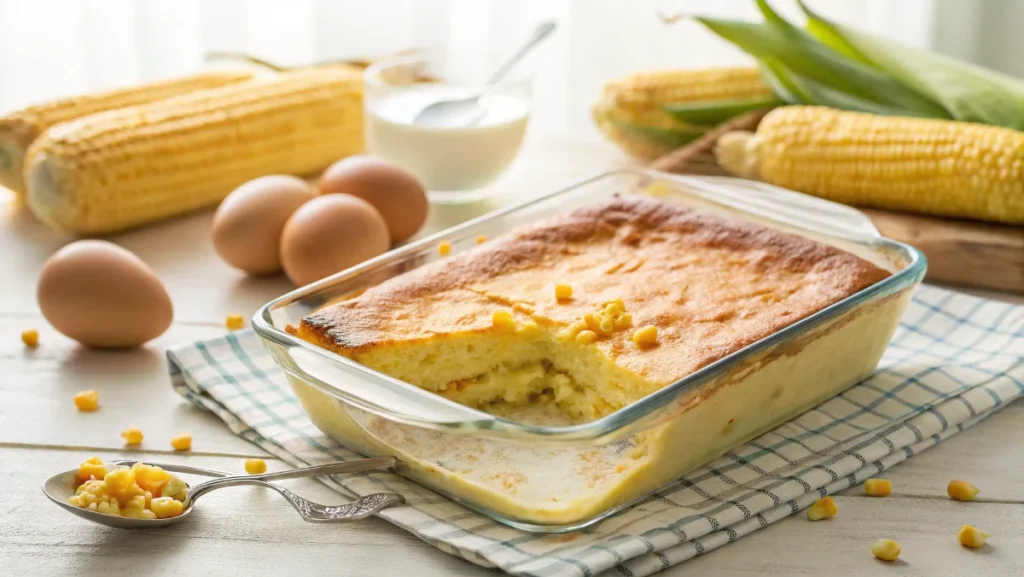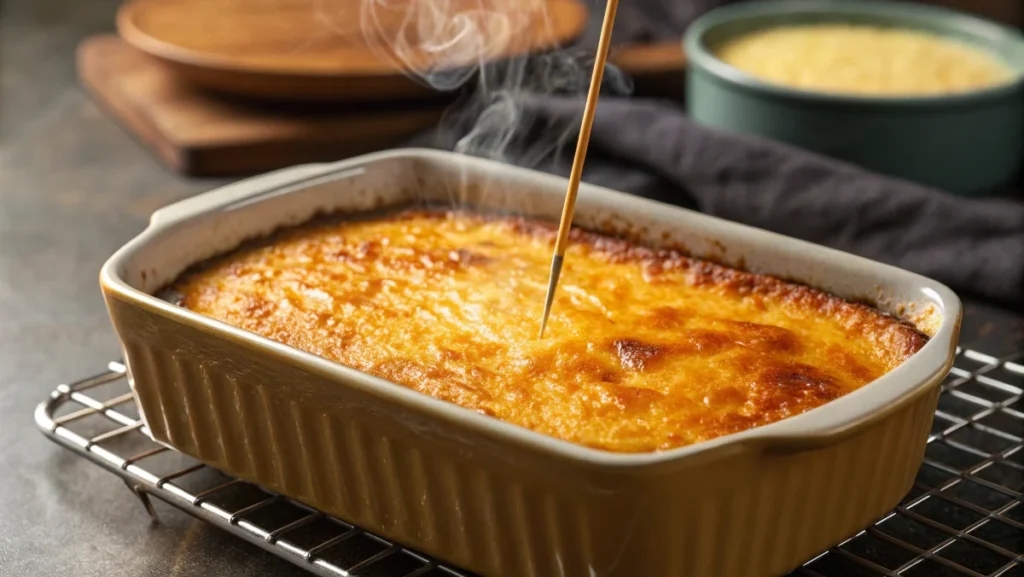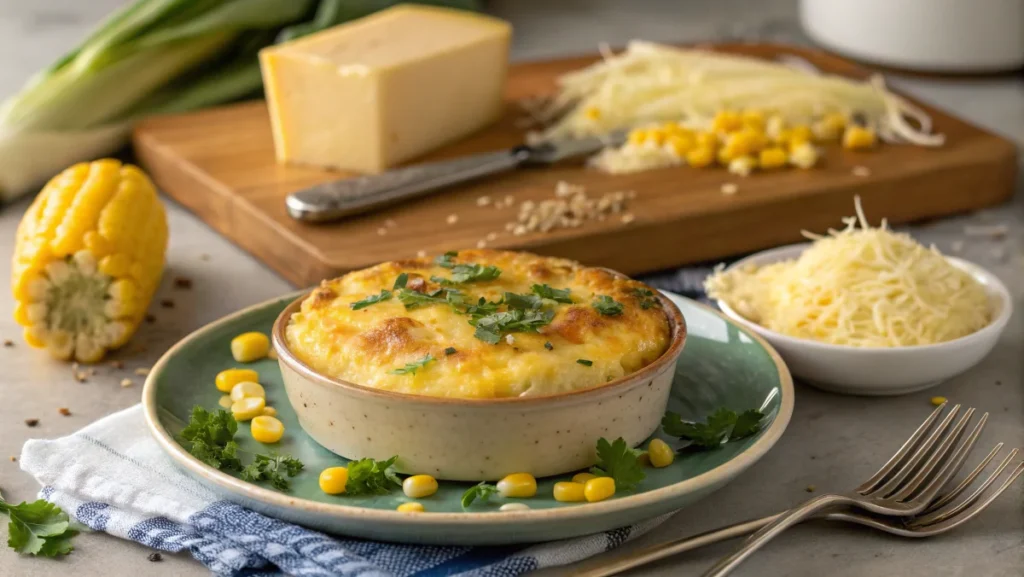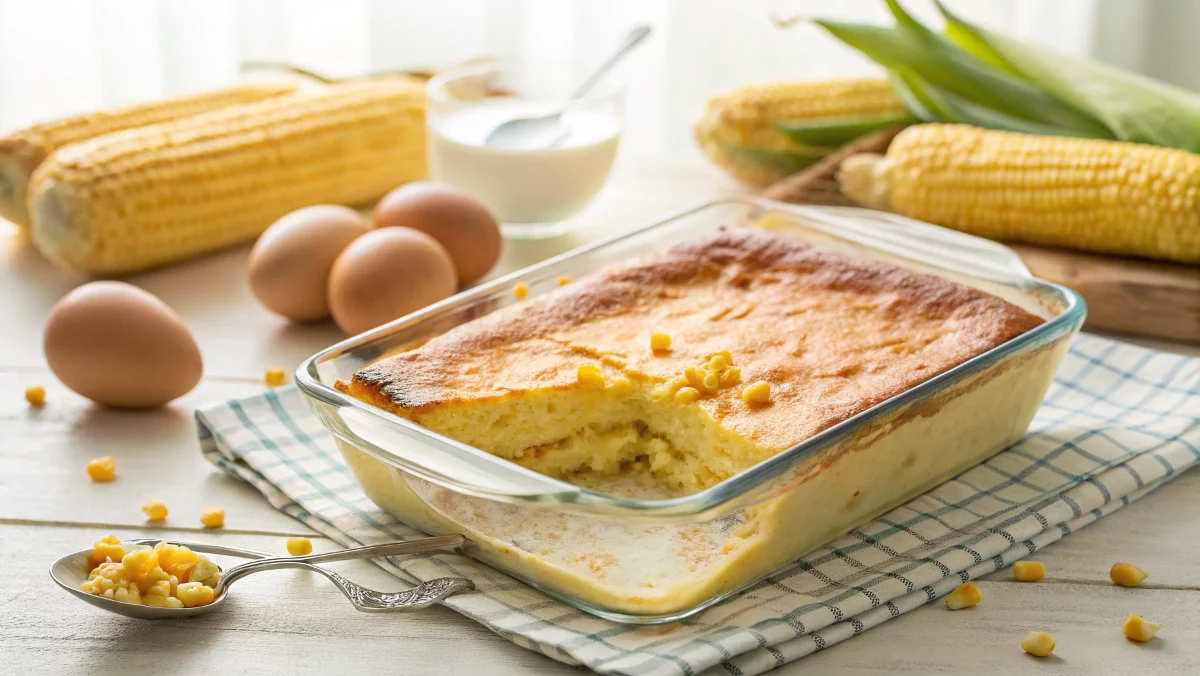Corn pudding is a classic dish enjoyed for its creamy, custard-like texture and sweet corn flavor. However, achieving the perfect consistency can sometimes be tricky. Many people wonder, “Why is my corn pudding soupy?”, as it often turns out watery or runny instead of smooth and firm. This article will dive deep into why this happens, offering practical fixes and tips to ensure your corn pudding turns out perfect every time. For a step-by-step recipe and expert advice, check out Corn Pudding Recipe: The Ultimate Guide to a Perfectly Irresistible Dish.

Table of Contents
Understanding Corn Pudding and Its Texture
What Is Corn Pudding?
Corn pudding is a baked dish made from a mixture of corn, milk or cream, eggs, and seasonings. Its consistency lies somewhere between a souffle and a casserole, offering a balance of creaminess and firmness. However, if not prepared correctly, you may find yourself asking, “Why is my corn pudding soupy?”
Why Consistency Matters
The dish’s texture is its most defining quality. A perfect corn pudding is creamy but not watery, with a custard-like base that holds its shape when served. Watery pudding can ruin the dish’s appeal, leaving diners disappointed.
The Science Behind Corn Pudding
Corn pudding relies on a delicate balance of liquids and stabilizers. Eggs and starches (like flour or cornstarch) act as binders, holding the liquid ingredients together as they cook. When the proportions or cooking methods are off, the pudding may become too watery, leaving you wondering, “Why is my corn pudding soupy?”
Common Reasons for Watery Corn Pudding
1. Too Much Liquid in the Recipe
One of the most common causes of watery corn pudding is adding too much liquid. Whether it’s milk, cream, or juice from canned corn, excess liquid can overwhelm the custard’s structure, making it runny.
Solution:
- Follow the recipe’s measurements carefully.
- If using canned corn, drain it thoroughly before adding it to the mix.
2. Undercooked Pudding
Undercooking is another major culprit. Corn pudding needs enough time in the oven for the custard to set properly. Pulling it out too early can leave the center raw and runny.
Solution:
- Bake at the recommended temperature (usually 350°F or 175°C) for 45-60 minutes.
- Test the center with a toothpick or knife—if it comes out clean, the pudding is done.
3. Improper Egg Mixture
Eggs play a crucial role in binding the ingredients. If the eggs aren’t mixed thoroughly or enough eggs are used, the custard won’t firm up properly.
Solution:
- Use 2-3 eggs for most standard recipes.
- Whisk the eggs until frothy before combining them with other ingredients.

The Role of Ingredients in Consistency
Eggs: The Binding Agent
Eggs are the backbone of a well-set corn pudding. They coagulate as they cook, forming a network that traps and holds liquid. Skipping eggs or using too few can leave the pudding unstable.
Pro Tip: For an extra creamy texture, consider adding an extra yolk.
Starches: Thickening the Mixture
Flour, cornstarch, or even instant pudding mix can be used to thicken the batter and absorb excess liquid. These ingredients act as stabilizers, ensuring the pudding sets firmly.
Pro Tip: Add 1-2 tablespoons of cornstarch to your batter for a foolproof thickening boost.
Milk and Cream: Balancing the Liquid
The type and amount of liquid used are key. Full-fat milk or heavy cream adds richness but must be measured carefully.
Pro Tip: Avoid using low-fat milk, as it may lead to a thinner custard.
Understanding the role of each ingredient helps you make adjustments and prevent watery results, so you won’t have to ask, “Why is my corn pudding soupy?” in the future.
How Cooking Techniques Affect Corn Pudding
Proper Baking Time and Temperature
Corn pudding needs to bake long enough for the custard to set. Undercooking or baking at too low a temperature can lead to a watery dish.
Best Practices:
- Preheat your oven to the correct temperature.
- Bake on the middle rack for even heat distribution.
The Toothpick Test
The easiest way to check if your pudding is done is to insert a toothpick or knife into the center. If it comes out clean, the pudding is fully cooked.
Pro Tip: If the edges are set but the center still jiggles slightly, let it bake for another 10 minutes.
Avoiding Overcrowding in the Oven
If you’re baking multiple dishes at once, ensure there’s enough space for air to circulate. Poor heat distribution can cause uneven cooking, leaving the center of your pudding watery and making you wonder, “Why is my corn pudding soupy?”
Pro Tip: Bake your corn pudding on its own or alongside dishes that require similar cooking times.

Fixing Watery Corn Pudding
1. Bake It Longer
If your corn pudding comes out watery, simply return it to the oven and bake for an additional 10-15 minutes. Cover the dish with foil to prevent the top from over-browning.
2. Use a Thickener
For a quick fix, sprinkle a small amount of cornstarch or flour over the surface of the pudding, then gently mix it in and bake for another 10 minutes.
3. Serve with Confidence
Sometimes, a slightly watery pudding can still taste delicious. Serve it warm with a spoon, or pair it with crusty bread to soak up the extra liquid. If you’re curious about the subtle differences between similar dishes, such as corn pudding and corn casserole, take a look at What’s the Difference Between Corn Pudding and Corn Casserole? for a comprehensive comparison to refine your culinary creations.
Preventive Tips for Perfect Corn Pudding Every Time
1. Follow a Reliable Recipe
Many issues arise from imbalanced recipes, often leading you to wonder, “Why is my corn pudding soupy?” Stick to tried-and-true recipes that have been tested and include precise measurements for ingredients.
Pro Tip: Bookmark or save recipes with clear instructions, especially ones with tips on adjusting consistency.
2. Use the Right Baking Dish
The choice of the baking dish matters. Shallow dishes allow even cooking, while deeper ones may result in undercooked centers.
Pro Tip: Opt for a glass or ceramic dish that distributes heat evenly.
3. Prepare Ingredients Correctly
Prepare your ingredients in advance, ensuring they’re at the right temperature. For example:
- Drain canned corn completely.
- Let frozen corn thaw and pat it dry.
- Use room-temperature milk and eggs.
4. Avoid Overmixing
Mixing the batter too vigorously introduces air, causing the pudding to collapse or remain watery, leaving you to ask, “Why is my corn pudding soupy?” Gently combine the ingredients until just incorporated.
By following these preventive measures, you can ensure a consistently firm, creamy corn pudding every time you bake it.
Enhancing Corn Pudding with Flavorful Additions
While addressing texture issues, don’t forget about flavor! Adding complementary ingredients can elevate your corn pudding without compromising its consistency or leaving you wondering, “Why is my corn pudding soupy?”
1. Cheese for a Savory Twist
Shredded cheddar, Parmesan, or Monterey Jack cheese can add a rich, savory element while also thickening the pudding.
Pro Tip: Sprinkle cheese on top during the last 10 minutes of baking for a golden, crispy crust.
2. Spices and Herbs
Enhance the flavor profile by adding spices like paprika, nutmeg, or cayenne pepper. Fresh herbs like thyme, parsley, or chives also work well.
3. Vegetables for Texture
Diced bell peppers, onions, or jalapeños not only add flavor but also contribute texture that can balance out a watery consistency.
Pro Tip: Sauté vegetables before adding them to the batter to avoid excess moisture.
4. Sweet Additions for a Dessert Pudding
For a sweeter variation, mix in honey, brown sugar, or cinnamon. Additions like raisins or dried cranberries can complement the corn’s natural sweetness and help you avoid asking, “Why is my corn pudding soupy?”
Experimenting with add-ins can transform your corn pudding into a versatile dish suitable for any occasion.

Reheating and Storing Corn Pudding Without Losing Texture
Corn pudding leftovers can be just as delicious, but improper storage or reheating can leave you wondering, “Why is my corn pudding soupy?” Here’s how to avoid that:
1. Proper Storage
Allow the pudding to cool completely before transferring it to an airtight container. Refrigerate for up to 3 days.
Pro Tip: Place a paper towel over the pudding before sealing the container to absorb any excess moisture.
2. Reheating in the Oven
Avoid reheating corn pudding in the microwave, as it can introduce steam and make the dish watery. Instead:
- Preheat your oven to 300°F (150°C).
- Cover the pudding with foil to prevent it from drying out.
- Heat for 15-20 minutes, checking periodically.
3. Freezing Corn Pudding
If you plan to freeze the pudding, divide it into smaller portions to ensure even reheating later. Thaw it overnight in the refrigerator before reheating.
Pro Tip: Add a small pat of butter or a sprinkle of cheese before reheating to restore some of the moisture and flavor.
By following these methods, you can enjoy your corn pudding without compromising its texture or flavor.
Troubleshooting Other Common Issues
Even when your corn pudding isn’t watery, other issues can arise. Here’s how to address them:
1. Dry or Crumbly Pudding
If your pudding turns out too dry, it may have been overcooked or lacked sufficient liquid.
Fix: Add a splash of cream or milk to the batter next time and bake for a slightly shorter time.
2. Overly Sweet Pudding
If the dish is too sweet, it could be due to using sweetened canned corn or too much sugar.
Fix: Balance the sweetness by reducing sugar or adding a pinch of salt.
3. Burnt Edges or Top
If the edges or top of your pudding burn before the center is fully cooked, your oven may be too hot.
Fix: Use an oven thermometer to check the actual temperature. Cover the dish with foil halfway through baking.
4. Rubbery Texture
Rubbery corn pudding is usually a result of overmixing the batter or using too many eggs.
Fix: Reduce the number of eggs by one in your next attempt and mix the batter gently.
Addressing these issues ensures your corn pudding reaches its full potential every time you bake it.
FAQs About Watery Corn Pudding
Why Is My Corn Pudding Soupy?
A soupy corn pudding usually means that the ingredients haven’t set properly. This can happen for several reasons:
- Excess Liquid: If you’re using too much milk, cream, or undrained canned corn, the mixture can turn overly wet. Fresh corn may also release more liquid than expected.
- Undercooking: Corn pudding requires adequate baking time to set the custard-like consistency. Removing it too early leaves the center undercooked and runny.
- Poor Egg Mixture: Eggs are key to binding the ingredients together. Using too few eggs or not whisking them enough can weaken the custard structure.
- Not Letting It Rest: Corn pudding needs time to cool slightly after baking. Cutting into it too soon can make it appear soupy, as it hasn’t fully set.
What to Do If Pudding Is Too Watery?
A watery pudding can often be salvaged with a few simple steps:
- Bake Longer: If the pudding is watery after the initial cooking time, return it to the oven and bake for an additional 10-15 minutes. Cover the top with aluminum foil to prevent over-browning while the center sets.
- Add a Thickener: Mix 1-2 tablespoons of cornstarch or flour with a bit of water to create a slurry. Carefully fold it into the pudding and bake for another 10 minutes. This helps absorb excess moisture.
- Cool and Rest: Allow the pudding to cool for at least 15 minutes after removing it from the oven. This resting period gives the custard time to solidify and hold its shape.
How Do You Fix Watery Creamed Corn?
Watery creamed corn can ruin the texture of your dish, but it’s easy to fix:
- Simmer to Evaporate Liquid: Transfer the creamed corn to a stovetop pan and simmer it on low to medium heat. Stir frequently to allow excess liquid to evaporate.
- Use a Thickener: Combine a tablespoon of cornstarch or flour with cold water to create a slurry. Stir this mixture into the creamed corn and cook for a few minutes until it thickens.
- Choose the Right Corn: If you’re using canned corn, be sure to drain it thoroughly before cooking. Fresh or frozen corn should also be patted dry to remove any extra moisture.
Why Is My Corn Casserole So Runny?
Corn casserole, much like corn pudding, can end up runny if not cooked or prepared correctly. Here are the common reasons and fixes:
- Not Enough Baking Time: Runny corn casserole often results from undercooking. Bake at 350°F for at least 45-60 minutes, or until the center is set. Use a toothpick to test doneness—it should come out clean.
- Too Much Liquid: Overloading the batter with milk, cream, or juices from the corn can make the casserole soggy. Reduce the liquid amounts slightly or thoroughly drain any canned corn.
- Insufficient Stabilizers: A runny casserole might need more stabilizing ingredients like flour, cornstarch, or a box of cornbread mix. These absorb moisture and help bind the mixture.
- Let It Rest: Just like corn pudding, casseroles need time to cool and firm up after baking. Allow the dish to sit for 10-15 minutes before serving.
Conclusion
Corn pudding is a delightful dish that’s worth perfecting. By understanding the role of ingredients, mastering cooking techniques, and applying preventive measures, you can avoid asking, “Why is my corn pudding soupy?”, and enjoy a rich, creamy pudding every time. If you’re wondering about substitutions, such as using canned corn instead of creamed corn, this complete guide for recipes and substitutes offers detailed insights to help you make the best choice for your dish.

